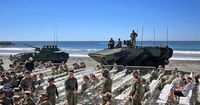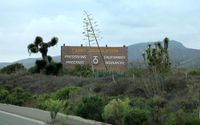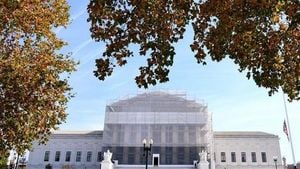On October 18, 2025, Southern California’s busiest highway, Interstate 5, fell unusually silent for a stretch of 17 miles as the U.S. Marine Corps staged a dramatic live-artillery demonstration at Camp Pendleton. The event, marking the Marine Corps’ 250th anniversary, was attended by Vice President JD Vance and Defense Secretary Pete Hegseth, drawing both fanfare and fierce criticism from state officials, commuters, and protest organizers alike.
In the days leading up to the exercise, the plan to fire live artillery shells over the heavily trafficked I-5 corridor set off a political firestorm. Governor Gavin Newsom, a Democrat, issued a series of sharp statements condemning the federal government’s decision to proceed. "The President is putting his ego over responsibility with this disregard for public safety," Newsom declared, as quoted by multiple outlets including FOX 5/KUSI and The New York Times. "Firing live rounds over a busy highway isn’t just wrong — it’s dangerous."
Despite his objections, the event went forward as scheduled. Early Saturday morning, state transportation officials, citing what they called an "extreme life safety risk" and the potential for hazardous driver distraction from sudden explosions, ordered the California Highway Patrol to close a 17-mile stretch of I-5 near Camp Pendleton. The closure, which began before and continued during the exercise, caused severe traffic delays throughout Saturday morning and early afternoon. According to the governor’s office, the I-5 corridor typically carries 80,000 travelers and $94 million in freight daily—making the disruption felt far and wide. Passenger rail services running parallel to the freeway were also canceled for the afternoon, compounding the region’s transportation woes.
The military, for its part, insisted the exercise was safe, routine, and meticulously planned. U.S. Marine Capt. Gregory Dreibelbis stated, "Weeks of deliberate planning and rehearsals ensured success at every phase of execution." He emphasized that artillery fire at Camp Pendleton is nearly a weekly occurrence and that the exercises posed no danger to motorists. Event organizers had even requested signage along the highway warning, "Overhead fire in progress," and "Live Weapons Over Freeway," to alert drivers to the unusual activity above.
Vice President JD Vance, a Marine Corps veteran himself, and his wife, Usha, observed the spectacle from the base. They watched as amphibious vehicles stormed the beach, aircraft streaked overhead, and columns of smoke rose from munitions strikes—an impressive display of military might meant to honor a quarter-millennium of Marine Corps history. The event was also attended by Defense Secretary Pete Hegseth and drew crowds of military families and dignitaries.
Yet, the controversy was not confined to political offices or the base perimeter. The live-fire demonstration coincided with the nationwide "No Kings" protest, which saw rallies in cities from San Diego to Washington, D.C., and beyond. Protesters decried what they saw as a "profoundly absurd show of force" intended to intimidate dissenters. In a statement to The New York Times, Governor Newsom said, "Using our military to intimidate people you disagree with isn’t strength—it’s reckless, it’s disrespectful, and it’s beneath the office the president holds."
Republican leaders, however, had a very different take. U.S. Rep. Darrell Issa, whose district lies east of Camp Pendleton, lambasted Newsom’s actions as "a spiteful publicity stunt." William Martin, spokesperson for Vice President Vance, accused the governor of misleading the public about safety risks. "If Gavin Newsom wants to oppose the training exercises that ensure our Armed Forces are the deadliest and most lethal fighting force in the world, then he can go right ahead," Martin said in a statement reported by The New York Times. He added, "The Marine Corps says it’s an established and safe practice. Newsom wants people to think this is an absurd show of force. The Marine Corps says it’s part of routine training at Camp Pendleton."
For those on the ground, the impact was immediate and tangible. Commuters between San Diego and Los Angeles faced delays of up to two hours, with alternate routes jammed and public transportation options abruptly suspended. Matt Rocco, spokesperson for the California Department of Transportation, summed up the situation: "This is all because of the White House-directed military event, that for the safety of the public, we need to shut down the freeway since they’re sending live ordinances over the freeway."
Despite the heated rhetoric and logistical headaches, no mishaps or accidents were reported in connection with the artillery fire. The Marines’ careful planning and adherence to established safety protocols appeared to pay off, at least in terms of immediate public safety outcomes. Still, the episode exposed deep divisions about the use of military force in public spaces and the balance between national security displays and civilian life.
The event’s timing and symbolism were impossible to ignore. As the Marine Corps celebrated its 250th anniversary—a milestone marked by demonstrations of amphibious assaults and cutting-edge weaponry—the debate over military pageantry versus public safety took center stage. For some, the show of force was a proud reminder of American military prowess and tradition. For others, it was an unnecessary risk and a troubling message at a time of heightened political protest.
As the sun set on Camp Pendleton and traffic slowly returned to the I-5, the questions lingered: Should military exercises ever disrupt the daily lives of tens of thousands of civilians? Is the spectacle worth the risk, even when no harm comes to pass? And, perhaps most pressingly for Californians caught in the gridlock—will the next such event be handled any differently?
The answers remain as divided as the traffic that backed up along the Pacific coast that day. What’s clear is that the intersection of national defense and public life is rarely smooth—and never without controversy.






